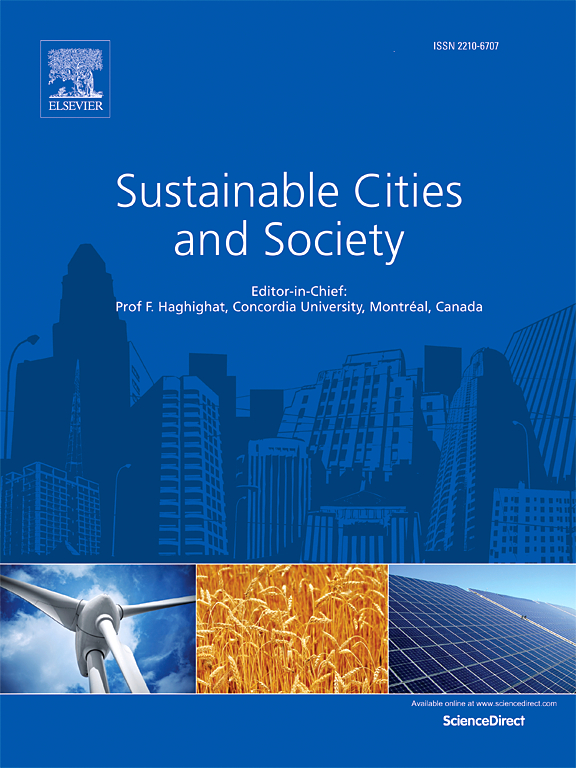A fuzzy-based optimization model for peak reduction in distribution networks through capacity bidding program
IF 10.5
1区 工程技术
Q1 CONSTRUCTION & BUILDING TECHNOLOGY
引用次数: 0
Abstract
Capacity Bidding Program (CBP) that incorporates an incentive-based mechanism holds significant promise in helping Distribution Companies (DISCOs) to address the challenges posed by extreme peaks. The primary focus of this paper is the peak reduction scheme (PRS) in distribution networks. The responsibility of the Distribution System Operator (DSO) is to reduce the peak demand of its service area below the quota determined by the Transmission System Operator (TSO). The CBP is studied besides the scheduled load interruption, which determines the optimal assignment and level of shedding for the load points. In order to achieve this goal, a numerical optimization model is examined. This model is based on fuzzy sets and aims to meet the PRS in a cost-effective manner. Additionally, it determines the optimal event hours for the participants of the CBP. The implementation of fuzzy modeling enables the DSO to effectively mitigate the risks related to the load, renewable generation, and the delivered capacity ratio by the CBP customers. The examination of proposed PRS on two test and real networks indicated that the nominated capacities and expected delivered quantities are influential in managing the scheduled interruption and determining CBP event calls to reduce peak demand below the quota. With a peak reduction share ranging from 1.2 % to 3.8 %, CBP customers can be considered reliable resources for peak management. Additionally, the real network experiences a 1.8 % increase in the cost of implementing the PRS scheme, as the delivered capacity is reduced by 23.4 % from the DSO's perspective.
基于容量竞标方案的配电网减峰模糊优化模型
容量竞标计划(CBP)结合了一种基于激励的机制,在帮助配电公司(DISCOs)应对极端峰值带来的挑战方面具有重要的前景。本文主要研究配电网的降峰方案(PRS)。配电系统运营商(DSO)的责任是将其服务区域的峰值需求降低到低于输电系统运营商(TSO)确定的配额。在研究负荷调度中断问题的基础上,对负荷点的最优分配和卸载水平进行了研究。为了实现这一目标,研究了一种数值优化模型。该模型基于模糊集,旨在以经济有效的方式满足可持续发展目标。此外,它还确定了CBP参与者的最佳活动时间。模糊建模的实施使DSO能够有效地降低与CBP客户的负荷、可再生能源发电和交付容量比相关的风险。在两个测试网络和实际网络上对拟议的PRS进行的检查表明,指定容量和预期交付数量对管理计划中断和确定CBP事件呼叫具有影响,以减少低于配额的峰值需求。由于峰值减少份额在1.2%至3.8%之间,CBP客户可以被认为是峰值管理的可靠资源。此外,实际网络实施PRS方案的成本增加了1.8%,因为从DSO的角度来看,交付的容量减少了23.4%。
本文章由计算机程序翻译,如有差异,请以英文原文为准。
求助全文
约1分钟内获得全文
求助全文
来源期刊

Sustainable Cities and Society
Social Sciences-Geography, Planning and Development
CiteScore
22.00
自引率
13.70%
发文量
810
审稿时长
27 days
期刊介绍:
Sustainable Cities and Society (SCS) is an international journal that focuses on fundamental and applied research to promote environmentally sustainable and socially resilient cities. The journal welcomes cross-cutting, multi-disciplinary research in various areas, including:
1. Smart cities and resilient environments;
2. Alternative/clean energy sources, energy distribution, distributed energy generation, and energy demand reduction/management;
3. Monitoring and improving air quality in built environment and cities (e.g., healthy built environment and air quality management);
4. Energy efficient, low/zero carbon, and green buildings/communities;
5. Climate change mitigation and adaptation in urban environments;
6. Green infrastructure and BMPs;
7. Environmental Footprint accounting and management;
8. Urban agriculture and forestry;
9. ICT, smart grid and intelligent infrastructure;
10. Urban design/planning, regulations, legislation, certification, economics, and policy;
11. Social aspects, impacts and resiliency of cities;
12. Behavior monitoring, analysis and change within urban communities;
13. Health monitoring and improvement;
14. Nexus issues related to sustainable cities and societies;
15. Smart city governance;
16. Decision Support Systems for trade-off and uncertainty analysis for improved management of cities and society;
17. Big data, machine learning, and artificial intelligence applications and case studies;
18. Critical infrastructure protection, including security, privacy, forensics, and reliability issues of cyber-physical systems.
19. Water footprint reduction and urban water distribution, harvesting, treatment, reuse and management;
20. Waste reduction and recycling;
21. Wastewater collection, treatment and recycling;
22. Smart, clean and healthy transportation systems and infrastructure;
 求助内容:
求助内容: 应助结果提醒方式:
应助结果提醒方式:


